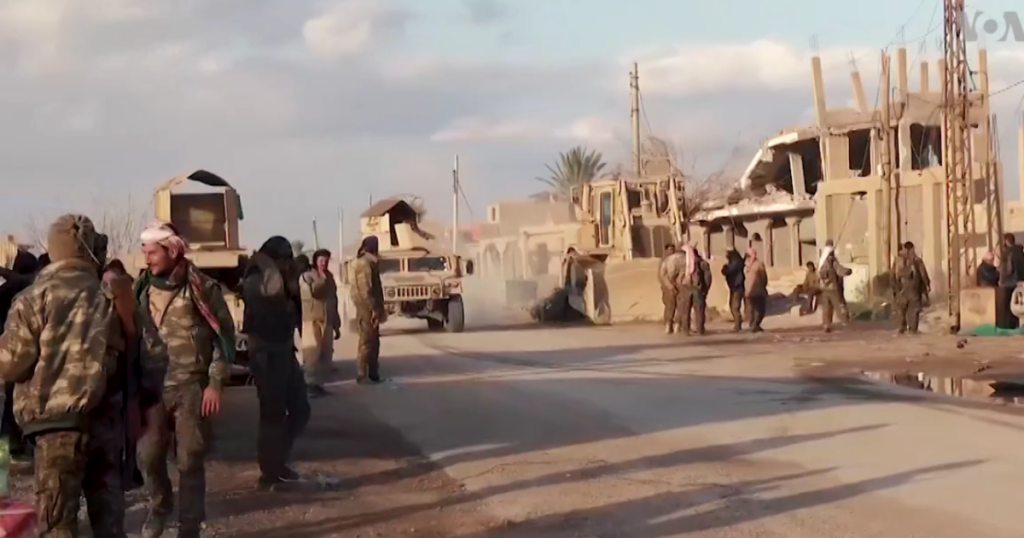By Voice of America – https://www.voanews.com/a/sdf-is-using-smoke-suicide-attacks-to-slow-advance-on-last-syria-stronghold/4784555.html, Public Domain, https://commons.wikimedia.org/w/index.php?curid=77295884
The US and Russia are already embroiled in a de facto proxy war in Ukraine. Now, with the escalating conflict in the Middle East, US foreign policy goals clash with Russia’s, effectively opening a second front. While it’s clear both Washington and Moscow pursue self-interest, their objectives and methods diverge significantly.
Both undertake military interventions and endorse proxy armies in the region. The distinction lies in Russia’s covert military involvement in the Middle East and Africa, primarily through private military companies (PMCs) like the Wagner Group. The US, however, overtly sends uniformed troops to the area. Russia’s PMCs have a notorious history of severe human rights violations, including rape, murder, and torture, leading to their designation as transnational terrorist organizations.
Another contrast in the policy objectives of the two countries lies in their motivations. While it’s often argued that the US only goes to war for oil, this assertion doesn’t hold up under scrutiny. Firstly, the US is among the nations with the largest proven oil reserves globally and is effectively energy independent.
Moreover, the US has participated in numerous conflicts in regions with minimal oil resources. For instance, during World War II, the US didn’t take on Japan and Germany because of their oil. Since 1945, the US has been involved in conflicts spanning Greece (1947-1949), Korea, Haiti (1959), Vietnam, Central America, Kosovo, Croatia, and many other countries. The most significant recent wars fought by the US were in Afghanistan, which lacks significant oil reserves, and Iraq, which is oil-rich. However, even in Iraq, the US didn’t seize control of the oil fields. The fields remain the property of Iraq, while they are operated by international companies, with China expanding its share.
Moscow’s interventions in the Middle East and Africa, on the other hand, are primarily driven by a quest to secure resources and strengthen the Russian economy. While the US typically backs the UN-recognized leader of a nation, the Wagner Group aligns itself with whichever strongman or dictator commands valuable resources such as gold, diamonds, or oil, funneling the proceeds back to Moscow through clandestine shell companies.
The U.S. typically ties its economic and military assistance to conditions aimed at enhancing democracy and human rights within a country. While one could argue that these conditions serve U.S. interests, they also contribute to the betterment of people’s lives.
Because Russia neglects human rights and democracy in the countries where it intervenes militarily, Moscow provides diplomatic and military backing for nefarious regimes such as Syria’s Bashar al-Assad, Libyan strongman Khalifa Haftar, or the coup leaders in the Sahel region of Africa. As a consequence of Russia’s support for these dictators, the standard of living and quality of life for the average citizens in these countries sharply decline.
Another contrast between US and Russian intervention lies in the aftermath: when a country aligns with Russia, it often severs ties with the West, as seen in the coup belt of Africa. This termination of Western influence not only hinders potential political and social transformations but also designates Russia as the principal export market, thereby reducing resource prices and exacerbating poverty.
On the other hand, countries aligning with the US effectively align with the EU, G7, and the world’s wealthiest and most developed nations. This alignment enables them to engage in international trade, access funding from traditional lenders like the IMF, World Bank, and Paris Club, and receive aid from Western sources.
Moscow and Washington have cooperated on counterterrorism issues, related to Islamic extremism, but once again, the motivations are different. Putin was quick to join US counterterrorism initiatives after the 9/11 terrorist attacks in the US, however, he was doing so, to cover for his war against separatists in Chechnya and Dagestan. Moscow’s alleged interest in counterterrorism is just the next step in a long history of repression and war against Russia’s domestic Muslim population.
Countries in the Middle East and Africa face a choice between the US and Russia as their counterterrorism and security partner. While the US seeks to balance counterterrorism efforts with maintaining relations with other Middle Eastern nations, Russia takes a different approach by indirectly supporting terrorism through its backing of Iran, which in turn supports Hamas, Hezbollah, and the Houthis. Russia provided Hamas with weapons taken in Ukraine and has sold weapons to authoritarian regimes all over Africa. Moreover, due to human rights violations committed by Moscow-sponsored groups, Russia has been labeled a state sponsor of terror by the EU Parliament.
Additionally, in response to the Houthi attacks on ships in the Red Sea, Russia obtained an agreement wherein the Houthis would refrain from attacking Russian vessels. In contrast, the US response involved forming an international coalition to prevent the Houthis from targeting ships of any nation.
The two countries have markedly different approaches to arms control. While the US collaborates with the international community to prevent states like North Korea and Iran from acquiring nuclear weapons, Russia takes a contrasting stance by providing technology to Iran that could advance its nuclear ambitions. Russia also purchases missiles and drones from Iran, as well as assorted munitions from North Korea, despite international sanctions prohibiting such arms trade. Moreover, supplying Iran with the means to develop nuclear weapons is banned, but Russia declared last year that it no longer felt obliged to adhere to UN restrictions.
Russia maintains its position on the United Nations Security Council (UNSC) and has consistently vetoed interventions against dictators and despots. Recently, Russia vetoed a resolution aiming to ban nuclear weapons from space. This aligns with Russia’s track record of vetoing resolutions related to nuclear proliferation as well as interventions in the Middle East.
While critics may argue that the US seeks to limit the number of nuclear weapons in the world to maintain its military supremacy, it’s undeniable that a world without nuclear-armed states like North Korea and Iran would be significantly safer than the alternative presented by Russian policies. Moreover, in the Middle East, a scenario where the region’s UN-recognized and democratically elected leaders, supported by the international community, aren’t embroiled in endless conflicts against Russian proxies would undoubtedly lead to greater stability, prosperity, and, most importantly, the well-being of the Middle Eastern population.
The post US vs. Russia in the Middle East and Africa: Clash of Policy Agendas appeared first on The Gateway Pundit.




